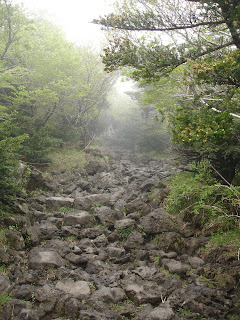The last post was a little long, so I didn’t describe our accommodations in Jeju. We stayed at Hwang To Mae Ul (http://hwangtomaeul.com/). Hwang To means orangish dirt, and this dirt is full of minerals and is supposed to have healing capabilities when you stay in the huts made out of it. Worth a shot, right? At the very least, it was a really cool, picturesque, unique, and authentic place to stay for a couple nights.
 Tuesday was our hiking day. Our goal: the Halla-san volcano rim. This volcano is nearly 2,000 meters tall and hasn’t erupted for probably about 1,000 years, so we figured we were pretty safe. Hiking in Korea is just a little different (should I just create an autotext in this series of posts for “a little different?”). The mountains are definitely steep and challenging, but most of the trails aren’t what I grew up hiking on in the Rockies. They are actually boardwalks and steps made out of wood or stone.
Tuesday was our hiking day. Our goal: the Halla-san volcano rim. This volcano is nearly 2,000 meters tall and hasn’t erupted for probably about 1,000 years, so we figured we were pretty safe. Hiking in Korea is just a little different (should I just create an autotext in this series of posts for “a little different?”). The mountains are definitely steep and challenging, but most of the trails aren’t what I grew up hiking on in the Rockies. They are actually boardwalks and steps made out of wood or stone.
It turned out to be a challenging, but really fun hike. The scenery was beautiful, and it was the best weather day in quite some time to hike up to the rim. Susie was wearing shorts and a jacket, and I was wearing jeans and a cotton shirt. We (especially Susie) got quite a few comments about our dress since most of the Koreans were outfitted in super technical gear with hats, gloves, balaclavas, nice boots, and hiking poles – everything name brand. The North Face is very popular in Korea. I bet some of them had a thousand bucks tied up in what they were wearing.
I don’t know if it’s because we have longer legs, or because we’ve hiked quite a bit in the past, but Susie and I generally hiked quite a bit faster than most of the Koreans on the trail. But we were impressed at the number of senior citizens making it to the top. They took it slower but they still had the stamina to pull it off. We finished in about 5 ½ hours, and to hear some of the comments in the parking lot you would have thought we’d just won Olympic gold.
We couldn’t see the summit from the trailhead due to quite a few clouds, and we spent a lot of the day hiking up and back through the clouds. Despite the boardwalks and stairs, there were a couple of challenging sections to the trail.


























































